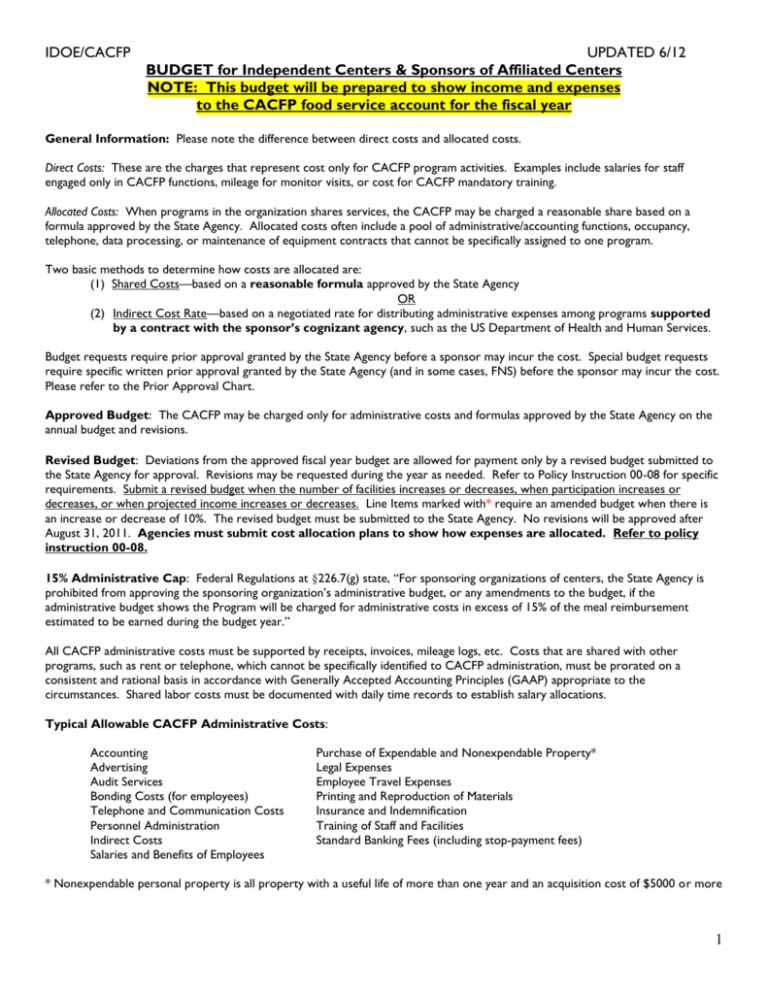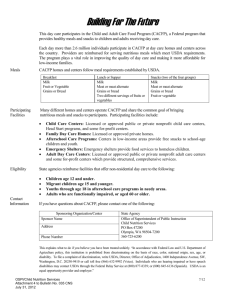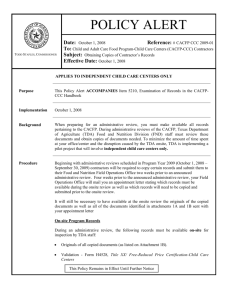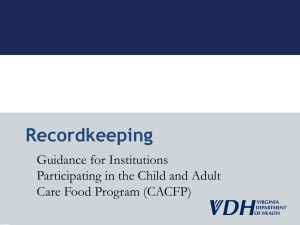IDOE/CACFP
advertisement

IDOE/CACFP UPDATED 6/12 BUDGET for Independent Centers & Sponsors of Affiliated Centers NOTE: This budget will be prepared to show income and expenses to the CACFP food service account for the fiscal year General Information: Please note the difference between direct costs and allocated costs. Direct Costs: These are the charges that represent cost only for CACFP program activities. Examples include salaries for staff engaged only in CACFP functions, mileage for monitor visits, or cost for CACFP mandatory training. Allocated Costs: When programs in the organization shares services, the CACFP may be charged a reasonable share based on a formula approved by the State Agency. Allocated costs often include a pool of administrative/accounting functions, occupancy, telephone, data processing, or maintenance of equipment contracts that cannot be specifically assigned to one program. Two basic methods to determine how costs are allocated are: (1) Shared Costs—based on a reasonable formula approved by the State Agency OR (2) Indirect Cost Rate—based on a negotiated rate for distributing administrative expenses among programs supported by a contract with the sponsor’s cognizant agency, such as the US Department of Health and Human Services. Budget requests require prior approval granted by the State Agency before a sponsor may incur the cost. Special budget requests require specific written prior approval granted by the State Agency (and in some cases, FNS) before the sponsor may incur the cost. Please refer to the Prior Approval Chart. Approved Budget: The CACFP may be charged only for administrative costs and formulas approved by the State Agency on the annual budget and revisions. Revised Budget: Deviations from the approved fiscal year budget are allowed for payment only by a revised budget submitted to the State Agency for approval. Revisions may be requested during the year as needed. Refer to Policy Instruction 00-08 for specific requirements. Submit a revised budget when the number of facilities increases or decreases, when participation increases or decreases, or when projected income increases or decreases. Line Items marked with* require an amended budget when there is an increase or decrease of 10%. The revised budget must be submitted to the State Agency. No revisions will be approved after August 31, 2011. Agencies must submit cost allocation plans to show how expenses are allocated. Refer to policy instruction 00-08. 15% Administrative Cap: Federal Regulations at §226.7(g) state, “For sponsoring organizations of centers, the State Agency is prohibited from approving the sponsoring organization’s administrative budget, or any amendments to the budget, if the administrative budget shows the Program will be charged for administrative costs in excess of 15% of the meal reimbursement estimated to be earned during the budget year.” All CACFP administrative costs must be supported by receipts, invoices, mileage logs, etc. Costs that are shared with other programs, such as rent or telephone, which cannot be specifically identified to CACFP administration, must be prorated on a consistent and rational basis in accordance with Generally Accepted Accounting Principles (GAAP) appropriate to the circumstances. Shared labor costs must be documented with daily time records to establish salary allocations. Typical Allowable CACFP Administrative Costs: Accounting Advertising Audit Services Bonding Costs (for employees) Telephone and Communication Costs Personnel Administration Indirect Costs Salaries and Benefits of Employees Purchase of Expendable and Nonexpendable Property* Legal Expenses Employee Travel Expenses Printing and Reproduction of Materials Insurance and Indemnification Training of Staff and Facilities Standard Banking Fees (including stop-payment fees) * Nonexpendable personal property is all property with a useful life of more than one year and an acquisition cost of $5000 or more 1 1. Anticipated Annual CACFP Reimbursement for the upcoming fiscal year: (A) Estimated Monthly Food Reimbursement (do not include Cash-in-lieu) X (B) Number of Operating Months per Year = (C) Total Estimated Annual Reimbursement X 15% (.15) = Maximum CACFP funds for administrative expenses. * * It is recommended that administrative costs for independent centers not exceed 15% of the total annual CACFP meal reimbursement. Calculate the current Food cost per child per day: 2. _________________÷ _________________ = _______________÷ ___________ = __________________ Est. Annual Food Cost # of Days Open/Year Cost of food/day ADA * Food Cost/Child/Day Line 1(a) *average daily attendance For State Agency Use Only Food Cost Approved by ____________________ (initials) Comments: 3. FINANCIAL VIABILITY Each institution must demonstrate that is has adequate financial resources to operate the CACFP on a daily basis, has adequate sources of funds to withstand temporary interruptions in CACFP payments and/or fiscal claims against the institution. THE FINAL RULE REQUIRED THAT INSTITUTIONS HAVE ENOUGH NON-PROGRAM FUNDS TO PAY EMPLOYEES/SUPPLIERS DURING PROGRAM PAYMENT INTERRUPTIONS AND TO PAY FOR PROGRAM OVERCLAIMS AND UNALLOWABLE COSTS List other center funds that will be used if CACFP monies are insufficient to pay all CACFP expenses (this must be shown in the budget on page 6), if Program funds are interrupted, and for overclaims and unallowable costs. (i.e. day care tuition, United Way Funds, Voucher payments, etc.) ______________________________________________________________________________________________ ______________________________________________________________________________________________ 4A) ACCOUNTABILITY: THIS SECTION APPLIES TO NON-PROFIT INSTITUTIONS, ONLY. List your agency’s current Board of Directors. (Attach chart or printed list if available). Include Board Position, Name, and Mailing Address. B) ACCOUNTABILITY: THIS SECTION APPLIES TO FOR-PROFIT AND PUBLIC INSTITUTIONS, ONLY. List at least two people from your organization that have administrative and financial responsibility for the overall operation of the agency and the CACFP. Include Position, Name, and Mailing Address. 2 5. ADMINISTRATIVE CAPABILITY (a) Each institution must be administratively capable, have appropriate staff and effective management practices, and have an adequate number and type of qualified staff. Provide a detailed organization administrative structure of your agency/center. Insert the structure below or attach an organization chart that includes all personnel working with CACFP. Include names and titles of staff, including all contracted services, such as an accountant, program advisor, trainer, dietitian, etc. Example: Director Center A Lynn Jones Cook Sara Lee Owner Barb Smith Director Center B Susie Apple Cook Jimmy Dean 6. FUND DISTRIBUTION TO SITES PARTICIPATING IN THE CACFP If the agency distributes reimbursement to each site, present a plan for reimbursement to the site(s) detailing the criteria used to determine the level of reimbursement. Describe the plan to ensure meal reimbursements are disbursed to sites within the time line of 5 days from receipt of monies from IDOE. If your agency is NOT reimbursing sites, write the word centralized to indicate the agency does NOT disburse CACFP monies to sites. If your organization operates in multiple states, are funds comingled or used by each state only? 7. DATA COLLECTION Describe procedures used for collecting each site’s documentation to prepare the monthly claim. (Sponsoring Organizations, ONLY) Records to be collected How often will records be turned in to main office? (e.g. weekly, monthly) Who is responsible for turning in or collecting records? How will records get from sites to main office? (e.g. site personnel will deliver) Where will current records be stored? (e.g. main office, site) Application for Free and Reduced-Price Meals Enrollment Forms Participant Eligibility Roster Attendance Records Meal Participation Records Menus Labor Time Logs Receipts/Invoices 3 Revised 04/06 LABOR WORKSHEET Sponsor ID Number: _______________________ TITLE DUTIES Example: Exec Dir Management Salaries Check Claim No. in Position ADMINISTRATIVE LABOR (Attach additional sheets if necessary) Salaries and fringe benefits for such staff as the director, assistant director, administrator, bookkeeper, monitor, trainer, etc. for time engaged in administrative responsibilities such as planning, organizing, managing, and supervising the CACFP at each site and the sponsoring organization’s office. 1 X X Hours per week spent on CACFP .5 X Number of weeks program operates per year X Wage per Hour = Annual Budgeted Amount X 52 X 20.00 520.00 X X X X X X X X X Total Management Salaries – Enter on Budget, Page 1, Line 2(a) $ Clerical Salaries X X X X X X X X X Total Clerical Salaries – Enter on Budget, Page 1, Line 2(b) $ Monitoring Salaries (Multi-Site ONLY) X X X X X X X X X Total Monitoring Salaries – Enter on Budget, Page 1, Line 2(c) $ TITLE Example: Teachers COOK DUTIES Help serve food, mark meal sheets No. in Position OPERATIONAL LABOR (Attach additional sheets if necessary) Salaries and fringe benefits for such staff as the cook, cook’s helpers, teachers, etc. for time engaged in the preparation and service of CACFP meals and snacks at each site. 6 X X X Hours per week spent on CACFP 5 X X X Number of weeks program operates per year 52 X Wage per Hour X X COOK’S HELPER X X X TEACHERS/CAREGIVERS X X X TEACHER ASSISTANTS-ASSISTANT CAREGIVERS JANITOR X X X X X X OTHER—PLEASE SPECIFY X X X 6.00 = Annual Budgeted Amount 9360.00 $ Total Operational Labor – Enter on Budget, Page 1, Line 1(d) 4 IDOE/CACFP Revised 6/12 Sponsor ID Number: ________________________ OVERHEAD COST WORKSHEET-- SUBMIT THIS WORKSHEET WITH YOUR BUDGET When programs in the organization share services, the CACFP may be charged a reasonable share based on a formula approved by the state agency. Allocated costs often include a pool of administrative/accounting functions, rent, utilities, trash removal, etc., that cannot be assigned specifically to one program. Two basic methods can be used to determine how costs are allocated: (1) Shared Costs: based on a reasonable formula approved by the state agency Allowed Cost Allocation Methods: Check the method(s) used by your agency to allocate costs. Show the math used to derive sponsor formulas for shared costs. Total CACFP Labor Dollars Total Labor Dollars = CACFP % Method #1 Labor Comparison CACFP Labor dollar ÷ Total Labor dollars = CACFP % (a) Total hours open = CACFP % (b) Method #2 Hours Shared Cost Number of hours per day CACFP meals/snacks are served Number of hours per day child care operates = CACFP % CACFP service hours Other (describe in detail) OR (2) Indirect Cost Rate: Based on a negotiated rate for distributing administrative expenses among programs supported by a contract with the sponsor’s cognizant agency, such as the U. S. Department of Health and Human Services. Contract with cognizant agency = % assigned all programs Attach contract showing indirect cost rate approved for overhead costs Compute your overhead cost allocation here: Category Cost per month X 12 = Annual Cost X CACFP % (a or b from table above) = CACFP Share for one year Rent Utilities Trash Removal Total annual cost for rent, utilities, and trash. Enter on Line 3a, first column Maximum charge for rent, utilities and trash paid for with CACFP funds: For Administrative Expenses on Budget: Cost per month X 12 = Annual Cost X CACFP % (a or b from table above) = CACFP Share for one year* Travel** [Line 2(d)] Communications** [Line 2(e)] General Office Supplies** [Line 2(f)] Contracted Services** [Line 2(g)] Training and Monitoring Costs** [Line 2(h)] MULTI SITE SPONSORS ONLY Other (Line 2(i)] EXPLAIN Total annual cost for administrative expenses: Enter annual cost in 1st column on lines shown above. Maximum amount for above administrative costs to be paid for with CACFP funds: 5 ANNUAL BUDGET SUMMARY FOR INDEPENDENT CENTERS & AFFILIATED CENTER SPONSORS Budget for the period: Sponsor ID Number:_____________________ Budget is based on ____________center(s). October 1, ___________ to Sponsor Name____________________________________________________ September 30, ________ PROGRAM NON I FOOD SERVICE INCOME ANNUAL AMOUNT (AB) (a) Children’s payments for food, ONLY (b) Adult payments for food, ONLY (c) CACFP reimbursement for meals served (meals times rates only) (d) Cash-in-lieu of commodities (e) Other food service income (list specific sources) catering (f) (g) TOTAL FOOD SERVICE INCOME * (h) Total Funding Available to Maintain Food Service Operation * II FOOD SERVICE EXPENSES Operational Costs: (a) Food (meals/snacks that are self-prepared or vended) (b) Food Delivery/Transportation Charges (NOT grocery shopping) (c) Non-Food Costs (d) Food Service Operational Labor (from Labor Worksheet)* (e) Purchased Services * (f) Other—List Specific Expense TOTAL OPERATIONAL COSTS 2. Administrative Costs: (a) Management Salaries (from Labor Worksheet) * (b) Clerical Salaries (from Labor Worksheet) * (c) Monitoring Salaries (from Labor Worksheet) * (d) Travel * (e) Communications (internet, postage, phone) (f) General Office Supplies (g) Contracted Services * (h) Training and Monitoring Costs (other than labor) (i) Other—List Specific Expenses (2j) TOTAL ADMINISTRATIVE COSTS * 3. Overhead Costs: (a) Total General Overhead Costs (from Overhead Cost Worksheet) * 4a TOTAL PROGRAM COSTS (1g + 2j + 3a) 4b PROGRAM FUNDED OTHER RESOURCES USED TO COVER FOOD SERVICE EXPENSES (Ques #3) 1. (1g) FUNDED CACFP AVAILABLE FUNDING LESS PROGRAM COSTS = This budget has been completed by: Printed Name:_______________________________________________ Phone Number: __________________________ Signature:__________________________________________________ Date:___________________________________ 6 DIRECTIONS FOR COMPLETING THE BUDGET Remember, the budget represents the annual cost to maintain the food service operation at your facility(ies). It will include CACFP reimbursement, other income, and funds transferred from other funds to cover food service expenses. Sponsors of Separate Legal Entities who reimburse sites must collect this information from each site being sponsored. The sponsor will review each budget for allowability, financial viability, and completeness. Keep these budgets in your files. Do not submit to the State Agency. Sponsors of Centers and Sponsors of Separate Legal Entities who provide the food service and do not reimburse sponsored sites, will complete this budget packet only. Page 4 will reflect the total cost to operate the food service for all of the sites being sponsored. You must amend your budget at least quarterly when you add and lose sites. Page 1: Page 2: Page 3: Information only. Pay special attention to the parts regarding revised budgets and the 15% administrative cap. 1. Compute the estimated annual reimbursement (this should be meal reimbursement ONLY. Do not include cash-in-lieu payments) 2. Determine 15% of your estimated annual reimbursement. (The 15% is the total of the Sponsor administrative costs and the unaffiliated center administrative costs. The unaffiliated centers cannot have any administrative costs if the sponsoring organization uses the 15%.) 3. Calculate the food cost per child per day. 4. List the funding resources to pay for food service expenses that exceed CACFP reimbursement. 5. List either your Board of Directors (non-profit) or two different people who have administrative and financial responsibility for the organization (for-profit). 6. Attach a copy of your most current organization chart showing the relationship of CACFP staff to the entire organization. 7. Explain how your organization disburses CACFP reimbursement to sites. (Sponsoring Organizations, ONLY) 8. Complete the chart to show how your organization will collect documents for preparation of the monthly claims. (Sponsoring Organizations, ONLY) Page 4-5: 9. Complete the Labor and Overhead Cost Worksheets Page 6: 10. Be sure to indicate the number of facilities you intend to operate during the fiscal year 11. The Annual Budget Column (AB) contains the total income, transferred funds, or expense to the non-profit food service for each line item for the entire fiscal year. You should have a past history of income and expenses to use as a basis for your figures. The line items listed should each have an annual amount. Then, they will either be paid for with all CACFP funds, all other funds, or a combination of the two. 12. The CACFP Funded column (CF) shows how you will spend the estimated annual reimbursement. Line 2j, middle column, cannot exceed 15% of your estimated annual CACFP reimbursement. You calculated that dollar amount on page 2, number 2. 13. The Other Funded column (OF) is the difference between a and b (above). 14. The budget must be signed and dated by a representative of the organization in order for the budget to be approved. Be sure to keep a copy of the budget pages for your records. Every organization will be required to submit a budget each program year as part of the contract renewal process. 7





